As urban areas continue to grow at an unprecedented rate, the concept of smart cities is revolutionizing urban development. By integrating advanced technologies and sustainable practices, cities can enhance the quality of life for residents while minimizing their environmental footprint.
The role of civil engineering in this transformation is crucial, as it involves designing and implementing infrastructure that supports the needs of a growing population while promoting eco-friendly practices.
Key Takeaways
- Cities are adopting smart technologies to improve resident’s quality of life.
- Sustainable practices are being integrated into urban development.
- Civil engineering plays a vital role in sustainable urban transformation.
- Advanced technologies are being used to minimize environmental impact.
- Eco-friendly infrastructure is becoming a priority in urban planning.
Understanding Sustainable Urban Transformation
Civil engineers play a vital role in driving sustainable urban transformation. As cities continue to grow and face increasing environmental challenges, the need for sustainable infrastructure development has become more pressing than ever.
Sustainability is a cornerstone of smart cities, and urban resilience is critical to withstanding the impacts of climate change. Resilient urban planning involves designing cities that can adapt to changing conditions while minimizing environmental impact.
Importance of Sustainability in Urban Development
Sustainable urban development is crucial for reducing the environmental footprint of cities. By incorporating green infrastructure, such as green roofs and walls, cities can mitigate the urban heat island effect and improve air quality. According to a study on sustainable urban development, such initiatives can significantly enhance urban livability.
Moreover, sustainable infrastructure development is key to supporting the growing urban population. It involves creating efficient transportation systems, reliable water management systems, and energy-efficient buildings. These elements are essential for creating livable and sustainable cities.
Key Challenges in Urban Transformation
Despite the importance of sustainable urban transformation, several challenges hinder its implementation. One of the primary challenges is the need for significant investment in sustainable infrastructure. Cities must balance the costs of new sustainable projects with the need for immediate infrastructure needs.
Another challenge is the integration of new technologies and practices into existing urban frameworks. This requires not only technological innovation but also changes in urban planning policies and practices. For instance, incorporating sustainable practices into urban development can help address these challenges.
Furthermore, urban transformation must be inclusive, ensuring that all segments of society benefit from new developments. This involves engaging communities in the planning process and ensuring that sustainable solutions are equitable and accessible to all.
Innovative Materials in Civil Engineering
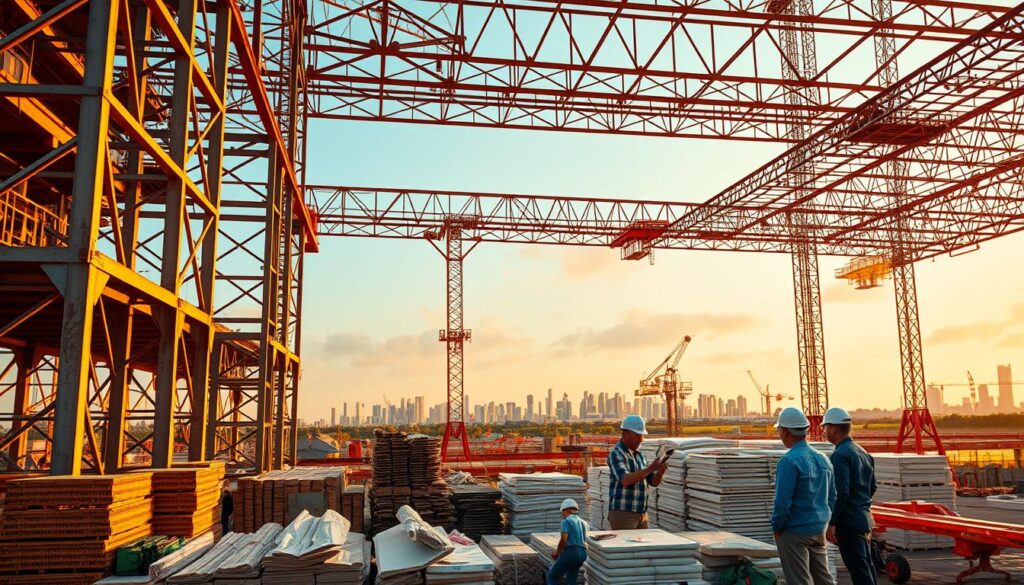
Innovative materials are revolutionizing the field of civil engineering, enabling more sustainable and durable constructions. The integration of such materials is crucial for reducing the environmental footprint of construction projects while enhancing the longevity and performance of infrastructure.
Recycled and Upcycled Materials
The use of recycled and upcycled materials is gaining traction in civil engineering. These materials not only reduce waste but also conserve natural resources. For instance, recycled concrete aggregates can replace virgin aggregates in new construction projects, reducing the need for quarrying and lowering carbon emissions. According to a study on sustainable building materials, the incorporation of recycled materials can significantly decrease the environmental impact of construction.
Some examples of recycled and upcycled materials include:
- Recycled glass
- Reclaimed wood
- Recycled metal
- Upcycled plastic
| Material | Original Use | New Application |
|---|---|---|
| Recycled Concrete | Demolition waste | Aggregate in new concrete |
| Reclaimed Wood | Old buildings | Structural beams |
| Recycled Glass | Bottles and windows | Aggregate in pavement |
Smart Materials and Their Applications
Smart materials are another innovation transforming civil engineering. For instance, self-healing concrete and adaptive building materials increase durability and reduce maintenance costs. Self-healing concrete contains bacteria that produce limestone, filling cracks and extending the material’s lifespan. As noted in an article on innovative construction materials, such materials are set to revolutionize the construction industry.
“The future of construction lies in sustainable and innovative materials that not only reduce environmental impact but also enhance the performance and longevity of infrastructure.”
The applications of smart materials are vast, ranging from self-healing infrastructure to adaptive building skins that adjust to environmental conditions. These materials contribute to more resilient and sustainable urban development.
Green Infrastructure: A Growing Trend
Green infrastructure is emerging as a critical component in the development of sustainable cities. As urban populations grow, the need for innovative solutions to manage environmental impacts becomes more pressing. Green infrastructure, including green roofs, urban forestry, and permeable pavements, plays a vital role in enhancing urban sustainability.
Benefits of Green Roofs and Walls
Green roofs and walls offer numerous benefits, including improved air quality, reduced urban heat island effects, and enhanced biodiversity. These structures provide insulation, reducing energy consumption and lowering utility bills. For instance, a study on green roofs in urban areas revealed a significant decrease in energy costs and improved air quality. To maximize these benefits, cities are incorporating green roofs into their green infrastructure solutions.
- Reduced energy consumption through improved insulation
- Enhanced biodiversity and urban ecosystems
- Improved air quality and reduced urban heat island effects
Incorporating Urban Forestry
Urban forestry is another crucial aspect of green infrastructure. Trees and green spaces in urban areas help mitigate the effects of climate change, improve air quality, and provide recreational spaces for residents. Effective urban forestry strategies involve selecting the right tree species, maintaining tree health, and engaging communities in tree planting initiatives. For more information on urban forestry and its benefits, visit World Civil Society.
Key benefits of urban forestry include:
- Climate change mitigation through carbon sequestration
- Improved air quality and reduced pollution
- Enhanced community engagement and social cohesion
Permeable Pavements
Permeable pavements are a sustainable alternative to traditional paving materials. They allow rainwater to percolate through the surface, reducing stormwater runoff and alleviating pressure on urban drainage systems. This not only helps prevent flooding but also contributes to groundwater recharge. For a detailed analysis of permeable pavements and their applications, refer to the research paper available at WJARR.
In conclusion, green infrastructure is a vital component of urban sustainability innovations. By incorporating green roofs, urban forestry, and permeable pavements, cities can create more sustainable, resilient, and livable environments for their residents.
Advanced Construction Technologies
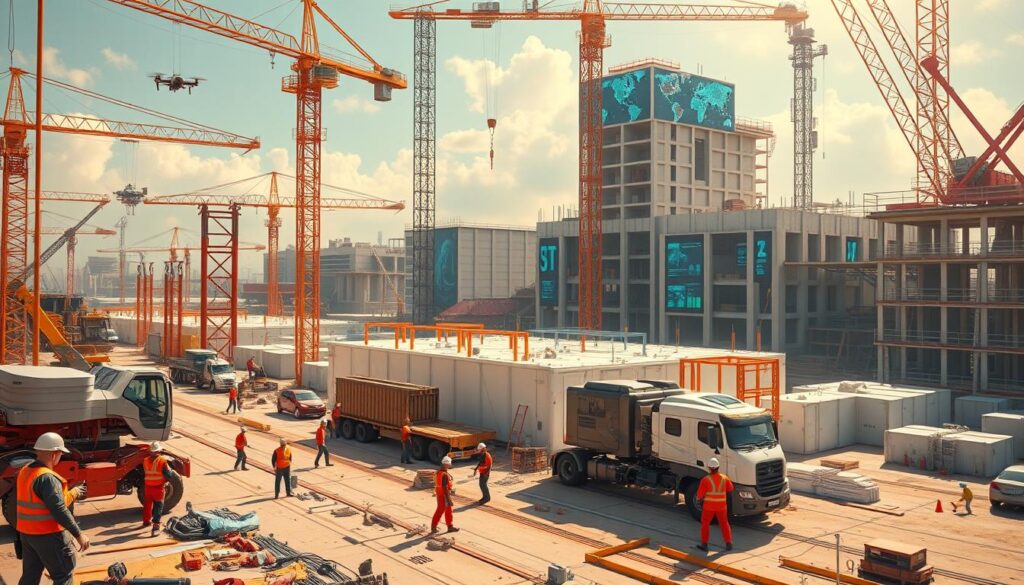
Advanced construction technologies are revolutionizing the civil engineering landscape, enabling the creation of more sustainable and resilient cities. The integration of digital tools and technologies such as Building Information Modeling (BIM), 3D printing, and Artificial Intelligence (AI) is transforming the way construction projects are planned, executed, and maintained.
3D Printing in Civil Engineering
3D printing is emerging as a game-changer in civil engineering, allowing for the rapid creation of complex structures with reduced material waste. This technology enables the construction of customized building components, such as architectural features and structural elements, with high precision.
The application of 3D printing in civil engineering is not only improving construction efficiency but also reducing environmental impact. By using locally sourced materials and minimizing waste, 3D printing contributes to more sustainable construction practices.
Modular and Prefabricated Construction Techniques
Modular and prefabricated construction techniques involve assembling building components in a factory before transporting them to the construction site. This approach significantly reduces on-site construction time and improves quality control.
The benefits of modular construction include reduced construction timelines, improved safety, and lower environmental impact. As the demand for efficient and sustainable construction methods grows, modular and prefabricated construction techniques are becoming increasingly popular in the civil engineering industry.
Robotics and Automation on Job Sites
The integration of robotics and automation on construction job sites is enhancing productivity and reducing labor costs. Robotic systems can perform a variety of tasks, from bricklaying to concrete finishing, with high precision and speed.
Automation technologies, including drones and autonomous equipment, are also improving site monitoring and management. By leveraging these technologies, civil engineers can optimize construction processes, reduce errors, and enhance overall project efficiency.
Smart Cities and Internet of Things (IoT)
Smart city initiatives are leveraging IoT to enhance urban management. The integration of IoT devices in urban infrastructure enables real-time data collection and analysis, which is crucial for improving urban living and reducing energy consumption.
Integrating IoT for Efficient Urban Management
The use of IoT in urban management involves the deployment of sensors and devices that monitor and control various aspects of city operations. This includes waste management, public safety, and energy usage. For instance, smart waste management systems can optimize waste collection routes and schedules based on real-time data, reducing operational costs and environmental impact.
According to a report, cities that adopt IoT technologies can significantly reduce their operational costs and improve the quality of life for their citizens. As noted by a city official, “IoT is not just about technology; it’s about using data to make our cities more livable and sustainable.”
“The future of our cities depends on our ability to integrate technology and urban planning effectively.”
Smart Transportation Systems
IoT is revolutionizing transportation systems in smart cities by making them more efficient and responsive to the needs of citizens. Smart traffic management systems can analyze real-time traffic data to optimize traffic light timings, reducing congestion and lowering emissions.
- Real-time traffic monitoring
- Smart traffic lights
- Intelligent public transit systems
For more information on how IoT is transforming urban living, visit this resource on smart cities and IoT.
Data-Driven Urban Planning
Data-driven urban planning is another significant application of IoT in smart cities. By analyzing data collected from various IoT devices, urban planners can make informed decisions about infrastructure development, public services, and resource allocation.
| Aspect | Traditional Approach | Data-Driven Approach |
|---|---|---|
| Infrastructure Development | Based on historical data and assumptions | Based on real-time data and predictive analytics |
| Public Services | Reactive, based on citizen complaints | Proactive, based on predictive analysis |
| Resource Allocation | Often inefficient, with misallocated resources | Optimized based on real-time needs |
The integration of IoT in smart cities is a step towards creating more sustainable, efficient, and livable urban environments. As cities continue to evolve, the role of IoT will become increasingly important in shaping their future.
Water Management Innovations
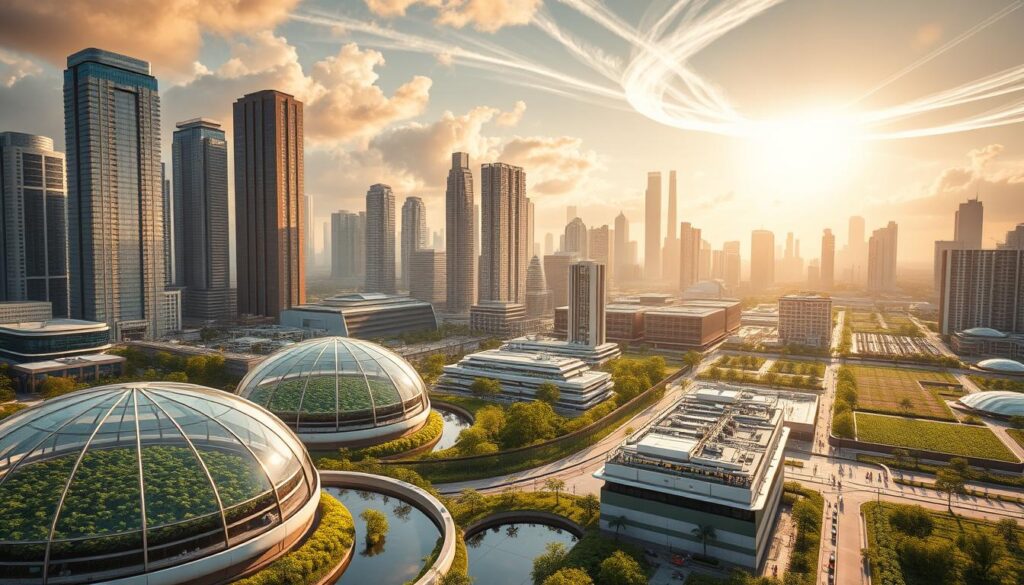
Climate change adaptation in urban design heavily relies on innovative water management. As urban areas face increasing challenges from climate change, including more frequent flooding and droughts, the need for effective water management strategies has never been more pressing.
Sustainable Drainage Systems (SuDS)
Sustainable Drainage Systems (SuDS) are designed to manage rainwater runoff in a way that mimics natural processes. By incorporating elements like permeable pavements, green roofs, and rain gardens, SuDS reduce the burden on urban drainage systems, minimizing the risk of flooding and improving water quality.
“SuDS not only help in managing stormwater runoff but also contribute to the aesthetic and biodiversity of urban environments,” says an expert in urban water management. This approach is crucial for cities looking to adapt to the impacts of climate change.
Water Recycling and Treatment Solutions
Water recycling and treatment solutions are vital for conserving water and reducing the demand on potable water supplies. Implementing rainwater harvesting and greywater recycling systems can significantly contribute to water sustainability in urban areas.
- Rainwater harvesting systems collect and store rainwater for non-potable uses, reducing the demand on municipal water supplies.
- Greywater recycling involves treating and reusing wastewater from sinks, showers, and washing machines for irrigation and flushing toilets.
By adopting these water management innovations, cities can enhance their resilience to climate change, ensuring a more sustainable future for their inhabitants.
Renewable Energy Solutions for Cities
Sustainable infrastructure development relies heavily on the adoption of renewable energy sources in urban planning. As cities continue to expand, the need for cleaner, more sustainable energy solutions becomes increasingly important.
Civil engineers are playing a crucial role in designing infrastructure that supports solar, wind, and other renewable energy sources. This involves not only the installation of renewable energy technologies but also ensuring that the infrastructure can support and enhance their efficiency.
Solar Panels and Urban Energy Systems
The integration of solar panels into urban energy systems is becoming more prevalent. Solar energy can be harnessed through photovoltaic panels installed on rooftops, in solar farms, or even integrated into building facades.
Urban energy systems that incorporate solar power can significantly reduce a city’s reliance on fossil fuels, thereby decreasing greenhouse gas emissions. Moreover, advancements in solar panel technology have made them more efficient and affordable.
Wind Energy Integration in Urban Areas
While wind energy is more traditionally associated with rural or offshore locations, there are innovative ways to integrate wind energy into urban areas. Urban wind turbines can be designed to be more compact and less intrusive, making them suitable for city environments.
The key to successful wind energy integration in cities is careful planning and assessment of wind patterns. Civil engineers must analyze urban landscapes to identify optimal locations for wind turbines, ensuring that they contribute to the city’s renewable energy mix without causing disturbance.
By embracing both solar and wind energy, cities can move towards a more sustainable and resilient energy future. This transition not only benefits the environment but also enhances energy security and can lead to economic benefits through the creation of green jobs and stimulation of local economies.
Sustainable Transportation Solutions
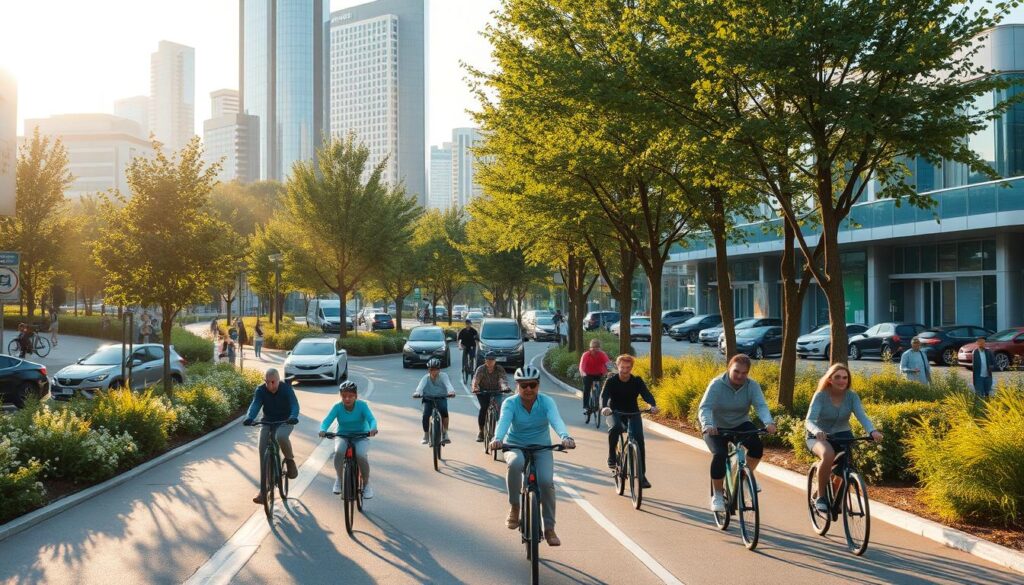
Civil engineers are at the forefront of developing sustainable transportation systems that reduce environmental impact. As urban areas continue to grow, the need for efficient, eco-friendly transportation solutions becomes increasingly critical.
Electric and Autonomous Vehicle Infrastructure
The shift towards electric and autonomous vehicles is transforming the transportation landscape. Electric vehicle charging infrastructure is being integrated into urban planning, with civil engineers designing smart charging systems that optimize energy use. Autonomous vehicles, on the other hand, promise to enhance safety and reduce traffic congestion. For more on how technology is changing civil engineering, visit this article on AI in civil.
Importance of Public Transit Expansion
Expanding public transit is a crucial aspect of sustainable transportation. Efficient public transit systems reduce reliance on private vehicles, decrease congestion, and lower emissions. Civil engineers play a vital role in designing and implementing these systems, ensuring they are reliable, accessible, and integrated with other modes of transport.
Promoting Non-Motorized Transport
Non-motorized transport, such as cycling and walking, is another key component of sustainable transportation. Cities are investing in dedicated bike lanes and pedestrian-friendly infrastructure to encourage these modes of transport. By doing so, they not only reduce environmental impact but also promote healthier lifestyles among their citizens.
By focusing on these areas, civil engineers can create transportation systems that are not only sustainable but also resilient and adaptable to future challenges.
Climate Resilience in Urban Design
As cities face the escalating threats of climate change, incorporating climate resilience into urban design has become a critical necessity. Urban areas are particularly vulnerable to the impacts of climate change, including rising temperatures, more frequent flooding, and increased risk of heatwaves.
To address these challenges, civil engineers and urban planners are adopting strategies for disaster risk reduction that enhance the resilience of urban infrastructure. This includes designing buildings and public spaces that can withstand extreme weather events and implementing early warning systems for natural disasters.
Disaster Risk Reduction Strategies
Effective disaster risk reduction involves a multi-faceted approach, including:
- Conducting thorough risk assessments to identify potential vulnerabilities.
- Implementing green infrastructure solutions such as green roofs and permeable pavements to manage stormwater runoff.
- Enhancing community preparedness through education and emergency planning.
For more detailed information on sustainable urban development, refer to the background document on sustainable urban development.
Climate-Adaptive Infrastructure
Climate-adaptive infrastructure is designed to withstand the projected impacts of climate change, ensuring that cities remain livable and functional. This includes:
- Upgrading water management systems to handle increased rainfall and flooding.
- Designing transportation systems that are resilient to extreme weather conditions.
- Incorporating climate resilience into urban planning to protect communities from the impacts of climate change.
By integrating climate resilience into urban design, cities can reduce the risks associated with climate change and create a more sustainable future for their residents.
Community Involvement in Urban Planning
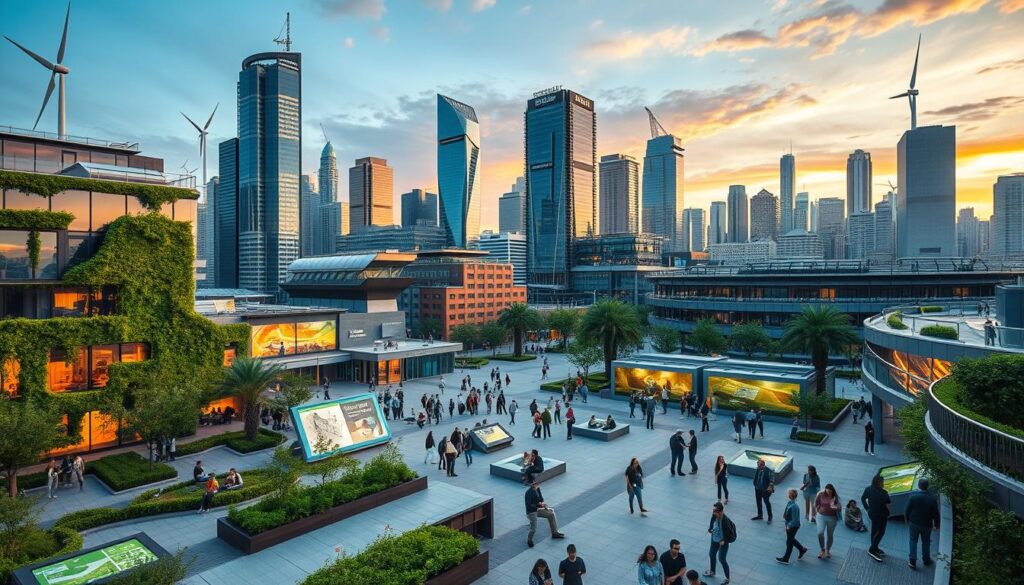
Community participation plays a vital role in shaping sustainable urban environments. Ensuring public awareness and acceptance of smart city initiatives is crucial for their success. By engaging the community in the planning process, cities can foster a sense of ownership and ensure that developments meet the needs of their residents.
Engaging Stakeholders Effectively
Effective stakeholder engagement is critical for the success of urban planning projects. This involves not only informing the public but also actively listening to their feedback and concerns. Cities can use various methods to engage stakeholders, including public meetings, surveys, and digital platforms.
For instance, the city of New York has implemented a participatory budgeting process, allowing residents to directly influence budget allocations for local projects. This approach has not only increased community involvement but also ensured that projects are more aligned with the community’s needs.
Approaches for Inclusive Design
Inclusive design is about creating urban spaces that are accessible and beneficial to all members of the community. This involves considering the needs of diverse populations, including the elderly, children, and people with disabilities. By adopting inclusive design principles, cities can create more equitable and sustainable environments.
One approach to inclusive design is the use of eco-friendly building materials and urban sustainability innovations. For example, green roofs and walls not only reduce energy consumption but also provide habitats for urban wildlife. Cities can also incorporate public art and community facilities into their urban planning to enhance the quality of life for residents.
| Approach | Description | Benefits |
|---|---|---|
| Participatory Budgeting | Involves citizens in budget allocation decisions | Increased community engagement, more relevant projects |
| Inclusive Design Principles | Focuses on accessibility and equity for all community members | More equitable urban spaces, enhanced quality of life |
| Eco-Friendly Materials | Use of sustainable materials in construction | Reduced environmental impact, healthier environments |
For more information on how engineering innovations can support community development, visit World Civil Society.
Legislation and Policy Changes
As cities evolve, policy changes play a crucial role in fostering sustainable urban transformation. The legislative framework within which civil engineering projects are developed is critical in determining the sustainability and environmental impact of these projects.
Impact of Policy on Sustainable Development
Government policies significantly influence the direction and adoption of sustainable practices in civil engineering. Policies that promote green infrastructure, for instance, can lead to increased investment in renewable energy and green buildings. The impact of these policies is multifaceted, affecting not only the environment but also the economy and public health.
Efficient policy frameworks can accelerate the transition to sustainable urban development by providing incentives for innovative technologies and practices. For example, tax incentives for companies that invest in green technologies can spur growth in the renewable energy sector.
“Policies that support sustainable development are crucial for creating resilient cities. By incentivizing green initiatives, governments can drive positive change.”
Government Incentives for Green Initiatives
Government incentives are vital for encouraging the adoption of green initiatives in civil engineering. These incentives can take various forms, including tax breaks, grants, and subsidies for projects that meet certain sustainability criteria.
- Tax incentives for green building projects
- Grants for research and development in sustainable technologies
- Subsidies for implementing energy-efficient systems
Such incentives not only benefit the environment but also stimulate economic growth by creating new opportunities in the green technology sector.
The role of legislation and policy changes in promoting sustainable urban transformation is undeniable. By understanding the impact of policy on sustainable development and leveraging government incentives, cities can move towards a more sustainable and resilient future.
Case Studies of Successful Sustainable Cities

Through the adoption of smart technologies, cities are enhancing their sustainability and setting new benchmarks for urban development. This section highlights successful case studies from the U.S. and global innovations in urban design.
Examples from the U.S.
The United States is home to several cities that have made significant strides in sustainable urban development. For instance, San Francisco has been at the forefront of integrating smart city technology to improve urban management. The city’s use of data analytics and IoT devices has enhanced its transportation systems, making them more efficient and reducing congestion.
Another notable example is New York City, which has implemented various resilient urban planning strategies. The city’s comprehensive plan to address climate change includes the development of green infrastructure and the promotion of sustainable transportation options.
Global Innovations in Urban Design
Globally, cities are also making significant progress in sustainable urban design. Cities like Singapore and Copenhagen are leading the way with innovative approaches to urban sustainability.
Singapore, for example, has developed a comprehensive smart nation initiative that integrates various technologies to enhance urban living. This includes smart transportation systems, energy-efficient buildings, and advanced water management systems.
Copenhagen, on the other hand, is renowned for its commitment to carbon neutrality. The city has implemented a range of initiatives, including the development of green roofs, bike-friendly infrastructure, and waste-to-energy systems.
These case studies demonstrate the potential for cities to become more sustainable through the integration of smart technologies and resilient urban planning strategies.
The Future of Civil Engineering for Urban Transformation
The future of civil engineering is closely tied to the development of sustainable cities. As urban populations continue to grow, the need for innovative and environmentally friendly infrastructure becomes increasingly important. Civil engineers will play a crucial role in shaping the cities of tomorrow by integrating sustainable infrastructure development and green infrastructure solutions.
Emerging Trends and Technologies
A multidisciplinary approach will be essential, combining engineering principles with technology, data analytics, and environmental science. This integration will enable the creation of efficient, resilient, and sustainable urban environments. The incorporation of green infrastructure solutions, such as green roofs and urban forestry, will not only mitigate the urban heat island effect but also improve air quality and enhance biodiversity.
Shaping Sustainable Urban Development
The role of technology in future projects will be pivotal, with advancements in 3D printing, modular construction, and data-driven urban planning leading the way. By leveraging these technologies, civil engineers can develop sustainable infrastructure that meets the needs of a growing urban population while minimizing environmental impact.
